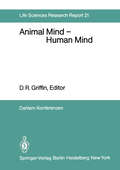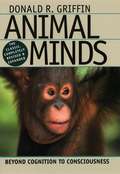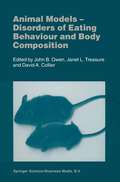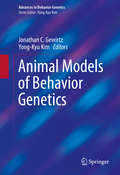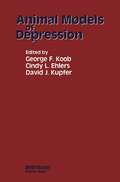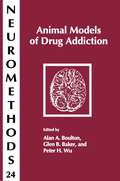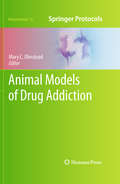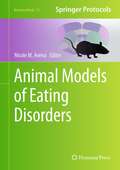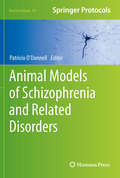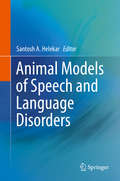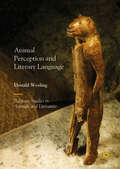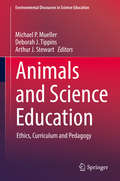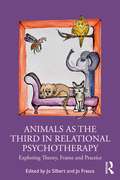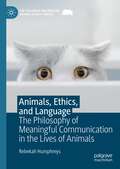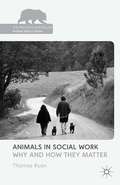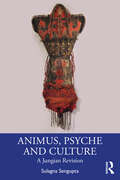- Table View
- List View
Animal Mind — Human Mind: Report of the Dahlem Workshop on Animal Mind — Human Mind, Berlin 1981, March 22–27 (Dahlem Workshop Report #21)
by M. Dawkins W. Kintsch H. J. Neville R. M. Seyfarth D. R. Griffin J. F. Bennett D. Dörner S. A. Hillyard B. K. Hölldobler H. S. Markl P. R. Marler D. Premackthe oleic acid on a live and wriggling sister or mother and refrain from evicting her from our hive. But does the occur rence of unintelligent behavior suffice to demonstrate the total absence of mental experience under any circumstances? Ethologists from some distant galaxy could easily discern ex amples of stupid and maladaptive behavior in our own species. But do instances of human stupidity prove that none of us is ever consciously aware of what he is dOing? No available evi dence compels us to believe that insects, or any other animals, experience any sort of consciousness, or intentionally plan any of their behavior. But neither are we compelled to believe the contrary. In areas where data are few and of limited rel evance, dogmatic negativity can easily limit what scientists even try to investigate, and thus perhaps delay or prevent im portant insights and discoveries. Many of the participants agreed that a good starting point would be to consider what we know of our own thinking, subjec tive feelings, and consciousness, and then move on to inquire whether other species experience anything similar. Such an ap proach was once considered fallaciously anthropomorphic. But it seems now to be widely if not universally recognized that this is a serious objection only if one has already assumed in advance that conscious thinking is uniquely human, and the accu sation of anthropomorphism is then merely a reiteration of the prior conviction.
Animal Minds: Beyond Cognition to Consciousness
by Donald R. GriffinIn Animal Minds, Donald R. Griffin takes us on a guided tour of the recent explosion of scientific research on animal mentality. Are animals consciously aware of anything, or are they merely living machines, incapable of conscious thoughts or emotional feelings? How can we tell? Such questions have long fascinated Griffin, who has been a pioneer at the forefront of research in animal cognition for decades, and is recognized as one of the leading behavioral ecologists of the twentieth century. With this new edition of his classic book, which he has completely revised and updated, Griffin moves beyond considerations of animal cognition to argue that scientists can and should investigate questions of animal consciousness. Using examples from studies of species ranging from chimpanzees and dolphins to birds and honeybees, he demonstrates how communication among animals can serve as a "window" into what animals think and feel, just as human speech and nonverbal communication tell us most of what we know about the thoughts and feelings of other people. Even when they don't communicate about it, animals respond with sometimes surprising versatility to new situations for which neither their genes nor their previous experiences have prepared them, and Griffin discusses what these behaviors can tell us about animal minds. He also reviews the latest research in cognitive neuroscience, which has revealed startling similarities in the neural mechanisms underlying brain functioning in both humans and other animals. Finally, in four chapters greatly expanded for this edition, Griffin considers the latest scientific research on animal consciousness, pro and con, and explores its profound philosophical and ethical implications.
Animal Minds: Beyond Cognition to Consciousness
by Donald R. GriffinIn Animal Minds, Donald R. Griffin takes us on a guided tour of the recent explosion of scientific research on animal mentality. Are animals consciously aware of anything, or are they merely living machines, incapable of conscious thoughts or emotional feelings? How can we tell? Such questions have long fascinated Griffin, who has been a pioneer at the forefront of research in animal cognition for decades, and is recognized as one of the leading behavioral ecologists of the twentieth century. With this new edition of his classic book, which he has completely revised and updated, Griffin moves beyond considerations of animal cognition to argue that scientists can and should investigate questions of animal consciousness. Using examples from studies of species ranging from chimpanzees and dolphins to birds and honeybees, he demonstrates how communication among animals can serve as a "window" into what animals think and feel, just as human speech and nonverbal communication tell us most of what we know about the thoughts and feelings of other people. Even when they don't communicate about it, animals respond with sometimes surprising versatility to new situations for which neither their genes nor their previous experiences have prepared them, and Griffin discusses what these behaviors can tell us about animal minds. He also reviews the latest research in cognitive neuroscience, which has revealed startling similarities in the neural mechanisms underlying brain functioning in both humans and other animals. Finally, in four chapters greatly expanded for this edition, Griffin considers the latest scientific research on animal consciousness, pro and con, and explores its profound philosophical and ethical implications.
Animal Minds: Beyond Cognition to Consciousness
by Donald R. GriffinIn Animal Minds, Donald R. Griffin takes us on a guided tour of the recent explosion of scientific research on animal mentality. Are animals consciously aware of anything, or are they merely living machines, incapable of conscious thoughts or emotional feelings? How can we tell? Such questions have long fascinated Griffin, who has been a pioneer at the forefront of research in animal cognition for decades, and is recognized as one of the leading behavioral ecologists of the twentieth century. With this new edition of his classic book, which he has completely revised and updated, Griffin moves beyond considerations of animal cognition to argue that scientists can and should investigate questions of animal consciousness. Using examples from studies of species ranging from chimpanzees and dolphins to birds and honeybees, he demonstrates how communication among animals can serve as a "window" into what animals think and feel, just as human speech and nonverbal communication tell us most of what we know about the thoughts and feelings of other people. Even when they don't communicate about it, animals respond with sometimes surprising versatility to new situations for which neither their genes nor their previous experiences have prepared them, and Griffin discusses what these behaviors can tell us about animal minds. He also reviews the latest research in cognitive neuroscience, which has revealed startling similarities in the neural mechanisms underlying brain functioning in both humans and other animals. Finally, in four chapters greatly expanded for this edition, Griffin considers the latest scientific research on animal consciousness, pro and con, and explores its profound philosophical and ethical implications.
Animal Minds: Beyond Cognition to Consciousness
by Donald R. GriffinIn Animal Minds, Donald R. Griffin takes us on a guided tour of the recent explosion of scientific research on animal mentality. Are animals consciously aware of anything, or are they merely living machines, incapable of conscious thoughts or emotional feelings? How can we tell? Such questions have long fascinated Griffin, who has been a pioneer at the forefront of research in animal cognition for decades, and is recognized as one of the leading behavioral ecologists of the twentieth century. With this new edition of his classic book, which he has completely revised and updated, Griffin moves beyond considerations of animal cognition to argue that scientists can and should investigate questions of animal consciousness. Using examples from studies of species ranging from chimpanzees and dolphins to birds and honeybees, he demonstrates how communication among animals can serve as a "window" into what animals think and feel, just as human speech and nonverbal communication tell us most of what we know about the thoughts and feelings of other people. Even when they don't communicate about it, animals respond with sometimes surprising versatility to new situations for which neither their genes nor their previous experiences have prepared them, and Griffin discusses what these behaviors can tell us about animal minds. He also reviews the latest research in cognitive neuroscience, which has revealed startling similarities in the neural mechanisms underlying brain functioning in both humans and other animals. Finally, in four chapters greatly expanded for this edition, Griffin considers the latest scientific research on animal consciousness, pro and con, and explores its profound philosophical and ethical implications.
Animal Minds: Beyond Cognition to Consciousness
by Donald R. GriffinIn Animal Minds, Donald R. Griffin takes us on a guided tour of the recent explosion of scientific research on animal mentality. Are animals consciously aware of anything, or are they merely living machines, incapable of conscious thoughts or emotional feelings? How can we tell? Such questions have long fascinated Griffin, who has been a pioneer at the forefront of research in animal cognition for decades, and is recognized as one of the leading behavioral ecologists of the twentieth century. With this new edition of his classic book, which he has completely revised and updated, Griffin moves beyond considerations of animal cognition to argue that scientists can and should investigate questions of animal consciousness. Using examples from studies of species ranging from chimpanzees and dolphins to birds and honeybees, he demonstrates how communication among animals can serve as a "window" into what animals think and feel, just as human speech and nonverbal communication tell us most of what we know about the thoughts and feelings of other people. Even when they don't communicate about it, animals respond with sometimes surprising versatility to new situations for which neither their genes nor their previous experiences have prepared them, and Griffin discusses what these behaviors can tell us about animal minds. He also reviews the latest research in cognitive neuroscience, which has revealed startling similarities in the neural mechanisms underlying brain functioning in both humans and other animals. Finally, in four chapters greatly expanded for this edition, Griffin considers the latest scientific research on animal consciousness, pro and con, and explores its profound philosophical and ethical implications.
Animal Minds: Beyond Cognition to Consciousness
by Donald R. GriffinIn Animal Minds, Donald R. Griffin takes us on a guided tour of the recent explosion of scientific research on animal mentality. Are animals consciously aware of anything, or are they merely living machines, incapable of conscious thoughts or emotional feelings? How can we tell? Such questions have long fascinated Griffin, who has been a pioneer at the forefront of research in animal cognition for decades, and is recognized as one of the leading behavioral ecologists of the twentieth century. With this new edition of his classic book, which he has completely revised and updated, Griffin moves beyond considerations of animal cognition to argue that scientists can and should investigate questions of animal consciousness. Using examples from studies of species ranging from chimpanzees and dolphins to birds and honeybees, he demonstrates how communication among animals can serve as a "window" into what animals think and feel, just as human speech and nonverbal communication tell us most of what we know about the thoughts and feelings of other people. Even when they don't communicate about it, animals respond with sometimes surprising versatility to new situations for which neither their genes nor their previous experiences have prepared them, and Griffin discusses what these behaviors can tell us about animal minds. He also reviews the latest research in cognitive neuroscience, which has revealed startling similarities in the neural mechanisms underlying brain functioning in both humans and other animals. Finally, in four chapters greatly expanded for this edition, Griffin considers the latest scientific research on animal consciousness, pro and con, and explores its profound philosophical and ethical implications.
Animal Models: Disorders of Eating Behaviour and Body Composition
by David A. Collier Janet L. Treasure John B. OwenThe book aims to review knowledge on the disorders of eating behaviour and body composition in some of the non-primate higher animals and to relate these to similar conditions in humans. With advances in understanding the nature of these disorders and their biological basis, it seems timely to assess what cross-species comparisons can tell us about the general underlying factors at work. This may also help to delineate what may be a general biological basis that humans share with their higher animal comrade species and what may distinguish human from non-human, particularly in a cultural context. This could help in combating better the problems of these conditions in the animal species as well as in man and in suggesting well-based preventive measures. As far as people are concerned the last two decades of the 20th century have shown a significant increase in obesity in the richer countries, particularly the USA (Table 1). Possibly associated with the obesity boom, there is an increasing awareness of other disorders of eating behaviour and body composition. These range from anorexia nervosa, at the other end of body composition to obesity, to others, such as bulimia, with more variable effects on body composition.
Animal Models in Radiotracer Design
by Richard M. Lambrecht William C. EckelmanThe editors have asked me to write this foreword probably for two reasons: First, I have spent 35 years trying to develop radiolabeled compounds that would help diagnose and treat disease. I, and the people from my laboratory, have been much involved with developing Nan'I for the diagnosis and treatment of hyperthyroidism and well-differentiated thyroid cancer. Second, I was a participant throughout the entire symposium upon which this book is based. Our latest '311-labeled compound, [l3lll metaiodobenzylguanidine, took us 13 years to develop. It has succeeded in diagnosing and treating adrenergic tumors '31 under circumstances where Na 1 would have failed for the diagnosis and treatment of thyroid cancer. I therefore hope that more scientists will be attracted to this field. This book is written by intelligent, experienced investigators who are knowl edgeable. It is a must for anyone new in the field. For the experienced, I would like to remind you that I attended the entire symposium; the breadth and timeliness of the update has helped us to redirect some of our current efforts into more scientifically productive channels. William H. Beierwaltes, M.D.
Animal Models of Behavior Genetics (Advances in Behavior Genetics)
by Jonathan C. Gewirtz Yong-Kyu KimThis stimulating analysis reviews the broad potential of animal models to foster a deeper understanding of human pathology, strengthen connections between genetic and behavioral studies, and develop more effective treatments for mental disorders. Widely-studied and lesser-used species are examined in models that capture features along the continuum of normative and pathological behavior. The models highlight genetic causes of core features, or endophenotypes, of developmental, internalizing, and externalizing disorders, as well as dementia. Expert contributors address questions ranging from how suitable species are chosen for study to the costs and benefits of using inbred versus outbred strains, and the effects of housing environment on subject animals. Larger issues addressed include how to evaluate the applicability of animal behavioral models to the human condition and how these models can harness emerging molecular technologies to further our understanding of the genetic basis of mental illness.Included in the coverage:Mating and fighting in Drosophila.Attachment and social bonding.Impulsivity in rodents and humans.Animal models of cognitive decline.Animal models of social cognition.Future directions for animal models in behavioral genetics.A detailed map of where this evolving field is headed, Animal Models of Behavior Genetics shows geneticists, molecular biologists, and cognitive neuroscientists paths beyond established concepts toward a more knowledgeable and collaborative future.
Animal Models of Depression
by KOOB EHLERS KUPFERAnimal models represent experimental investigations developed in one species for the purpose of studying phenomena in another species and provide numerous advantages for preclinical research. They allow scientists greater control and isolation of important experimental variables. Animal models are safe, reproducible strategies by which to evaluate and design new pharma cological treatment strategies, while also allowing direct central nervous system intervention to alter the course of the aberrant behavior. Animal models have been developed for a number of mental illnesses; in this particular domain, they hold the promise to shed light on the still obscure etiologies of these illnesses and ultimately to facilitate the development and testing of "cures. " Yet, true models of mental illness are difficult to develop, because mental illness may be a uniquely human phenomenon. It was based on these considerations that the MacArthur Foundation Research Network on the Psychobiology of Depression set out to sponsor a conference to review the status, problems, promises, and relevance of animal models to the clinical conditions of affective disorders. The conference was held in September 1986 and included participants from both within the Network as well as scientists and scholars from various disciplines relevant to the concerns of the conference. After the conference was held, it became clear to the organizers that the material presented could be helpful to a broader field of investigators, since a significant portion of the information has not been presented elsewhere or in the unified context of a monograph.
Animal Models of Drug Addiction (Neuromethods #24)
by Alan A. Boulton, Glen B. Baker and Peter H. Wuto the Animal Models Volumes This volume describes animal models of drug addiction. Because of increasing public concern over the ethical treatment of animals in research, we felt it incumbent upon us to include this general preface in order to indicate why we think further research using animals is necessary. Animals should only be used when suitable alternatives are not available, and humans can only be experimented upon in severely proscribed circumstances. Alternative procedures using cell or tissue culture are inadequate in any models requiring assessments of behavioral change or of complex in vivo p- cesses. However, when the distress, discomfort, or pain to the animals outweighs the anticipated gains for human welfare, the research is not ethical and should not be carried out. It is imperative that each individual researcher examine his/ her own research from a critical moral standpoint before eng- ing in it, and take into consideration the animals’ welfare as well as the anticipated gains. Furthermore, once a decision to p- ceed with research is made, it is the researcher’s responsibility to ensure that the animals’ welfare is of prime concern in terms of appropriate housing, feeding, and maximum reduction of any uncomfortable or distressing effects of the experimental conditions.
Animal Models of Drug Addiction (Neuromethods #53)
by Mary C. OlmsteadOur understanding of addiction and how it is treated has advanced remarkably over the past decades, and much of the progress is related directly to animal research. This is true for both the behavioural aspects of drug use as well as the biological underpinnings of the disorder. In Animal Models of Drug Addiction, experts in the field provide an up-to-date review of complex behavioural paradigms that model different stages of this disorder and explain how each test is used to effectively replicate the progression of drug addiction. This detailed and practical book begins with the most common laboratory measures of addiction in animals, including intracranial self-stimulation (ICSS), drug self-administration, place conditioning, and sensitization. Later chapters describe how these paradigms are used to model the progression of drug addiction, providing insight into the clinical symptomatology of addiction from acquisition of drug use through compulsive drug taking to withdrawal and relapse. Written for the popular Neuromethods series, the contributions offer both methodological detail and a theoretical perspective, appealing to readers familiar with preclinical research on drug addiction as well as those who are newcomers to the field. Cutting-edge and authoritative, Animal Models of Drug Addiction will serve as a basis for future vital research that links the bench to the bedside in the crucial treatment of drug addiction.
Animal Models of Eating Disorders (Neuromethods #74)
by Nicole M. AvenaThe growth of the field of eating disorder research has led to a vast array of empirical articles, and the development of new animal models that can be used to study these disorders continues to stimulate new research. Animal Models of Eating Disorders serves as a collection of detailed techniques contributed by experts in the field who are well-versed in the development and implementation of these models. Since eating disorders are complex and likely due to a combination of environmental, genetic, and social causes, the detailed chapters of this volume have been designed to highlight different contributing factors. Collectively, these chapters give a comprehensive and representative overview of both recently developed and classic methodologies used in the study of eating disorders. Written for the popular Neuromethods series, this work contains the kind of thorough description and implementation advice that promises successful results. Authoritative and practical, Animal Models of Eating Disorders aims to aid researchers in the use of animal models to assist in their investigation and characterization of the behaviors and neurochemical alterations associated with these devastating disorders.
Animal Models of Schizophrenia and Related Disorders (Neuromethods #59)
by Patricio O'DonnellAnimal models of schizophrenia and other major psychiatric disorders have been sought for decades, and, as a result, we are now facing new vistas on pathophysiology that could lead to novel therapeutic approaches and even hint at possible preventive strategies. Animal Models of Schizophrenia and Related Disorders presents an overview of the information that can be obtained with several different models and a detailed account of how to generate such models in order to ensure that the manipulations used to model schizophrenia-relevant phenomena are used consistently across laboratories. This detailed volume features pharmacological models such as non-competing NMDA antagonists, emphasizing their use in vitro, neurodevelopmental models such as the neonatal ventral hippocampal lesion and the antimitotic MAM, models that reproduce environmental factors such as neonatal hypoxia, vitamin D deficits, and prenatal immune activation, as well as several different genetic model approaches. As a volume in the Neuromethods series, this volume contains the kind of detailed description and implementation advice that is crucial for getting optimal results.Practical and cutting-edge, Animal Models of Schizophrenia and Related Disorders highlights the successes in the use of animal models to gain insight on pathophysiological mechanisms of relevance to major psychiatric disorders in the hope of inspiring investigators to expand the research and test targets that could restore or ameliorate function.
Animal Models of Speech and Language Disorders
by Santosh A. HelekarBasic research over the last decade or two has uncovered similarities between speech, especially its sensori-motor aspects, and vocal communication in several non-human species. The most comprehensive studies so far have been conducted in songbirds. Songbirds offer us a model system to study the interactions between developmental or genetic predispositions and tutor-dependent influences, on the learning of vocal communication. Songbird research has elucidated cellular and molecular mechanisms underlying learning and production of vocal patterns, perception of vocal sounds, vocal motor control and vocal neuromotor plasticity. More recently, the entire genome of the songbird zebra finch has been sequenced. These discoveries, along with the identification of several genes implicated in familial human speech and language disorders, have made it possible to look for analogues of speech and language dysfunction in zebra finches, at least at the perceptual and sensori-motor levels. Two approaches in particular have led us closer to the development of animal models of human speech conditions, namely developmental stuttering and a familial verbal dyspraxia associated with a mutation in the gene for the transcription factor FoxP2. Work on other animals that show developmental sensori-motor learning of vocal sounds used for communication have also shown significant progress, leading to the possibility of development of models of speech and language dysfunction in them. Among mammals, the principal ones include dolphins and whales. In non-human primates, while vocal learning per se is not very prominent, investigations on their communicative abilities have thrown some light on the rudiments of language. These considerations make the publication of a book focused on animal models of speech and language disorders, detailing the overall investigative approach of neurobehavioral studies in animals capable of vocal communication and learned vocalizations, a much-needed and worthwhile project. It would serve as a unifying review of research in this new multidisciplinary frontier, spanning the molecular to the behavioral, for clinicians and researchers, as well as a teaching resource for advanced speech pathology and neuroscience students. This book will also be the first of its kind.
Animal Perception and Literary Language (Palgrave Studies in Animals and Literature)
by Donald WeslingAnimal Perception and Literary Language shows that the perceptual content of reading and writing derives from our embodied minds. Donald Wesling considers how humans, evolved from animals, have learned to code perception of movement into sentences and scenes. The book first specifies terms and questions in animal philosophy and surveys recent work on perception, then describes attributes of multispecies thinking and defines a tradition of writers in this lineage. Finally, the text concludes with literature coming into full focus in twelve case studies of varied readings. Overall, Wesling's book offers not a new method of literary criticism, but a reveal of what we all do with perceptual content when we read.
Animals and Science Education: Ethics, Curriculum and Pedagogy (Environmental Discourses in Science Education #2)
by Michael P. Mueller Deborah J. Tippins Arthur J. StewartThis book discusses how we can inspire today’s youth to engage in challenging and productive discussions around the past, present and future role of animals in science education. Animals play a large role in the sciences and science education and yet they remain one of the least visible topics in the educational literature. This book is intended to cultivate research topics, conversations, and dispositions for the ethical use of animals in science and education. This book explores the vital role of animals with/in science education, specimens, protected species, and other associated issues with regards to the role of animals in science. Topics explored include ethical, curriculum and pedagogical dimensions, involving invertebrates, engineering solutions that contribute to ecosystems, the experiences of animals under our care, aesthetic and contemplative practices alongside science, school-based ethical dialogue, nature study for promoting inquiry and sustainability, the challenge of whether animals need to be used for science whatsoever, reconceptualizing museum specimens, cultivating socioscientific issues and epistemic practice, cultural integrity and citizen science, the care and nurturance of gender-balanced curriculum choices for science education, and theoretical conversations around cultivating critical thinking skills and ethical dispositions. The diverse authors in this book take on the logic of domination and symbolic violence embodied within the scientific enterprise that has systematically subjugated animals and nature, and emboldened the anthropocentric and exploitative expressions for the future role of animals.At a time when animals are getting excluded from classrooms (too dangerous! too many allergies! too dirty!), this book is an important counterpoint. Interacting with animals helps students develop empathy, learn to care for living things, engage with content. We need more animals in the science curriculum, not less.David Sobel, Senior Faculty, Education Department, Antioch University New England
Animals as the Third in Relational Psychotherapy: Exploring Theory, Frame and Practice
by Jo Silbert and Jo FrascaAnimals as the Third in Relational Psychotherapy: Exploring Theory, Frame and Practice elegantly and skilfully weaves together relevant literature, clinical reflections, compelling case material and contemporary psychoanalytic theory to demonstrate how the presence of an animal in the treatment arena can eventually bring about relational, interpersonal and intrapsychic change. Contemporary relational psychoanalytic literature has been virtually silent about our relationship with animals, a feature seemingly intrinsic to our relational worlds. This book seeks to remediate this void by giving voice to the practice and principles of working relationally in the presence of an animal. The text accentuates recurrent themes: animals are seen by human beings as significant subjective others and are treated as legitimate partners for relational and interpersonal processes, attachment figures and transferential objects; animals in the psychotherapy environment can play the role as a ‘bridge’ from the unconscious to the conscious, from the dissociated to the experienced, from the intrapsychic to the interpersonal; as the third in the treatment arena, the animal helps to reveal the field, bringing conflicts to life and making them available for analysis in the clinical setting. In seeking to authorise the incorporation of animals into the practice of relational psychotherapy the text applies conventional concepts to novel contexts; it extends psychoanalytic and relational principles to create a theoretical framework within which to consider the therapeutic effects of working in the triadic interactions of therapist, client and animal and thus also begins to evolve a new version of relational psychoanalytic practice. The authors value the human-animal experience in treatment and repeatedly show how the application of a relational psychoanalytic lens to the patient-therapist-animal triad can enhance the therapeutic process in ways that encourage progressive communication, understanding of the patient and the relaxing of defences, leading to the symbolising of relational capacity, therapeutic breakthrough and intrapsychic change.
Animals as the Third in Relational Psychotherapy: Exploring Theory, Frame and Practice
by Jo Silbert Jo FrascaAnimals as the Third in Relational Psychotherapy: Exploring Theory, Frame and Practice elegantly and skilfully weaves together relevant literature, clinical reflections, compelling case material and contemporary psychoanalytic theory to demonstrate how the presence of an animal in the treatment arena can eventually bring about relational, interpersonal and intrapsychic change. Contemporary relational psychoanalytic literature has been virtually silent about our relationship with animals, a feature seemingly intrinsic to our relational worlds. This book seeks to remediate this void by giving voice to the practice and principles of working relationally in the presence of an animal. The text accentuates recurrent themes: animals are seen by human beings as significant subjective others and are treated as legitimate partners for relational and interpersonal processes, attachment figures and transferential objects; animals in the psychotherapy environment can play the role as a ‘bridge’ from the unconscious to the conscious, from the dissociated to the experienced, from the intrapsychic to the interpersonal; as the third in the treatment arena, the animal helps to reveal the field, bringing conflicts to life and making them available for analysis in the clinical setting. In seeking to authorise the incorporation of animals into the practice of relational psychotherapy the text applies conventional concepts to novel contexts; it extends psychoanalytic and relational principles to create a theoretical framework within which to consider the therapeutic effects of working in the triadic interactions of therapist, client and animal and thus also begins to evolve a new version of relational psychoanalytic practice. The authors value the human-animal experience in treatment and repeatedly show how the application of a relational psychoanalytic lens to the patient-therapist-animal triad can enhance the therapeutic process in ways that encourage progressive communication, understanding of the patient and the relaxing of defences, leading to the symbolising of relational capacity, therapeutic breakthrough and intrapsychic change.
Animals, Ethics, and Language: The Philosophy of Meaningful Communication in the Lives of Animals (The Palgrave Macmillan Animal Ethics Series)
by Rebekah HumphreysWith an ever-growing body of evidence on the links between different oppressions, never have the debates in Critical Animal Studies surrounding intersectionality in relation to animal ethics been more important. In particular, the arguments related to anthropomorphic attributes of mentality to other than humans promise to provide fruitful new ground for re-assessing human-animal relations. This book maps the central debates surrounding anthropomorphism in relation to our descriptions of animals, their lives, animal mentality, and meaningful communication in the nonhuman world. Rebekah Humphreys synthesizes the work of critical animal theorists, philosophers, and cognitive ethologists, and provides a critical account of how the debates concerning anthropomorphism play a key role in a proper understanding of animal ethics.
Animals in Social Work: Why and How They Matter (The Palgrave Macmillan Animal Ethics Series)
by Thomas RyanThis collection of essays articulates theoretical and philosophical arguments, and advances practical applications, as to why animals ought to matter to social work, in and of themselves. It serves as a persuasive corrective to the current invisibility of animals in contemporary social work practice and thought.
Animus, Psyche and Culture: A Jungian Revision
by Sulagna SenguptaAnimus, Psyche and Culture takes Carl Jung’s concept of contra-sexual psyche and locates it within the cultural expanse of India, using ethnographic narratives, history, religion, myth, films, biographical extracts to deliberate on the feminine in psychological, social and archetypal realms. Jung’s concept of unconscious contra-sexuality, based on notions of feminine Eros and masculine Logos, was pioneering in his time, but took masculine and feminine to be fixed and essential attributes of gender in the psyche. This book explores the relevance of the animus, examining its rationale in current contexts of gender fluidity. Taking off from Post Jungian critiques, it proposes an exposition of the animus in history, social and religious phenomena, theories of knowledge, psychoid archetype and synchronicity, to grasp its nuances in diverse cultural worlds. This study re-envisions the notion of animus keeping in mind the intricacies of feminine subjectivity and the diversity of cultural worlds where depth psychological ideas are currently emerging. A remarkable reworking of Jungian ideas, this well-researched and important new book will be an insightful read for Jungian analysts and scholars with an interest in cultural and gender studies.
Animus, Psyche and Culture: A Jungian Revision
by Sulagna SenguptaAnimus, Psyche and Culture takes Carl Jung’s concept of contra-sexual psyche and locates it within the cultural expanse of India, using ethnographic narratives, history, religion, myth, films, biographical extracts to deliberate on the feminine in psychological, social and archetypal realms. Jung’s concept of unconscious contra-sexuality, based on notions of feminine Eros and masculine Logos, was pioneering in his time, but took masculine and feminine to be fixed and essential attributes of gender in the psyche. This book explores the relevance of the animus, examining its rationale in current contexts of gender fluidity. Taking off from Post Jungian critiques, it proposes an exposition of the animus in history, social and religious phenomena, theories of knowledge, psychoid archetype and synchronicity, to grasp its nuances in diverse cultural worlds. This study re-envisions the notion of animus keeping in mind the intricacies of feminine subjectivity and the diversity of cultural worlds where depth psychological ideas are currently emerging. A remarkable reworking of Jungian ideas, this well-researched and important new book will be an insightful read for Jungian analysts and scholars with an interest in cultural and gender studies.
Ankle Joint Arthroscopy: A Step-by-Step Guide
by Francesco Allegra Fabrizio Cortese Francesco LijoiThis book provides a comprehensive overview of current arthroscopic techniques for the management of ankle joint disorders. An introductory section clearly and accessibly explains the anatomy in question, the portal placement and other ankle procedures, addressing both the articular and extra-articular compartments. All currently available minimally invasive surgical options and the management of various upper and lower lesions of the ankle are then described step by step, discussing the main issues concerning each of them and sharing useful tips and tricks. A closing chapter is devoted to rehabilitation, which greatly differs in patients treated with arthroscopic procedures and those undergoing open surgery. The volume is also supplemented by detailed videos for each technique and procedure, both outside on the cutaneous layer and inside the joint. The book offers an invaluable tool for orthopedic surgeons and fellows dealing with foot and ankle disorders who normally prefer to use open procedures and desire to complement their surgical options with arthroscopy, as well as for those surgeons already familiar with arthroscopic techniques who would like to broaden their knowledge of the field.
